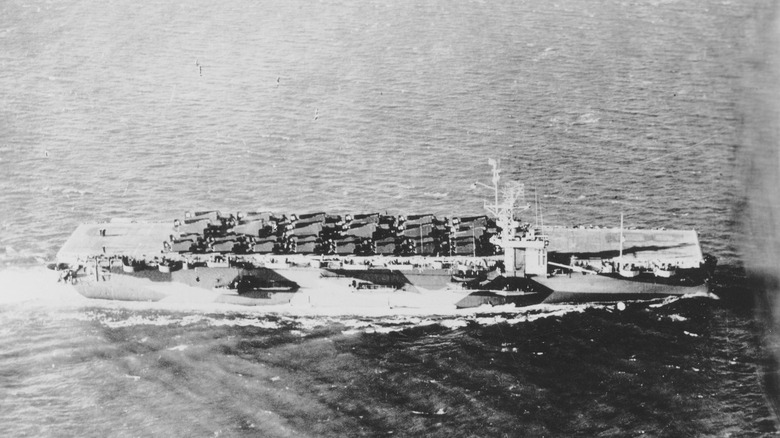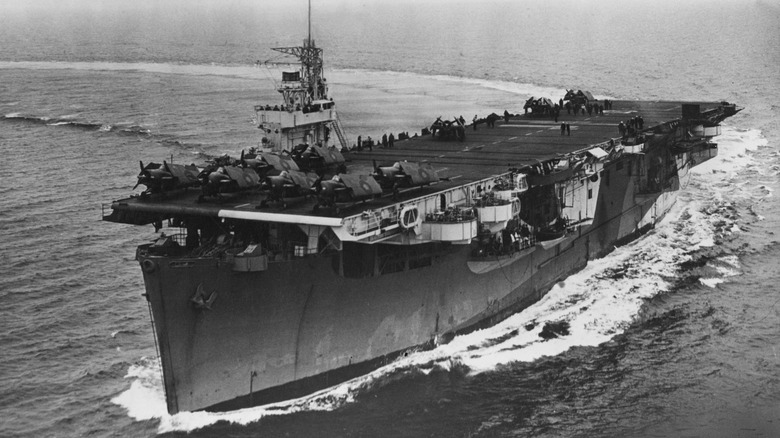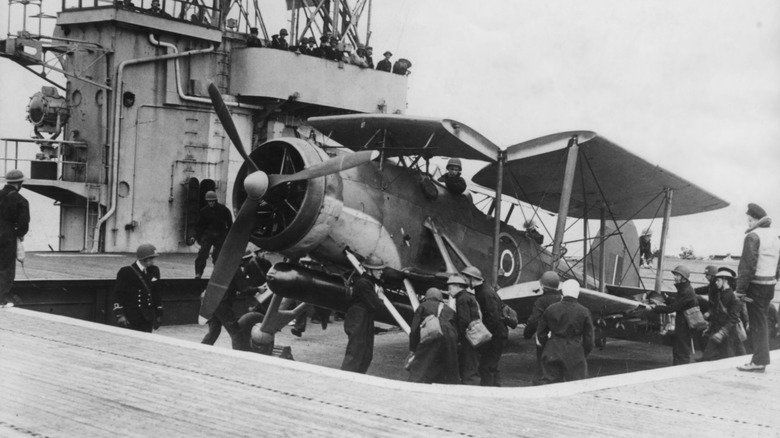What Is An Escort Carrier And How Does It Differ From A Fleet Carrier?
In the annals of naval combat, few creations have impacted how we wage war at sea and on land quite as much as the aircraft carrier. These floating fortresses were conceived, in part, for the purpose of stretching a Navy's ability to transport and launch fighter planes and various support aircraft from water-bound parts of the globe, thus enabling them to scout and better battle their enemies over land or water.
Today, each country with a massive military has multiple aircraft carriers, either fueled by diesel or nuclear. These massive ships are a far cry from the U.S. Navy's first ever aircraft carrier, the USS Langley, or even the purpose built carrier the Japanese Navy debuted at the same time. Over the years, there have been several different takes on carrier class vessels, including the escort class, which was largely used by the U.S. Navy and Allied Forces during World War II.
As the name dictates, escort carriers were largely used in a "support and protect" capacity during the conflict, meaning they were typically relegated to following alongside slower Naval merchant convoys and sending up planes to defend the fleet whenever enemy craft were encountered at sea. Yes, escort carriers were indeed capable of carrying multiple Naval aircraft, just like the Navy's supersized fleet carrier class vessels. That fact may leave many of you wondering exactly what the difference is between the two. Well, the main differences stem from their size and how they were used in battle.
Escort carriers were versatile fleet protectors
It may seem obvious, but when it comes to aircraft carriers, size really does matter. In that regard, escort carriers were not quite as revered for their contributions to the U.S. Navy's war effort as fleet carriers, as they were roughly half the size of their counterparts. They were also considerably slower than fleet carriers and, you guessed it, couldn't carry anywhere near as many aircraft into battle.
Because of those facts, escort carriers were considerably faster and cheaper to build than fleet carriers, which is precisely why they came into existence during the conflict. Indeed, escort carriers were not part of the Navy's fleet until just before the United States entered World War II and were conceived largely because top Naval officials believed the U.S. would need considerably more carrier class vessels if they were to hold their own against the vast German fleet. It was ultimately decided that producing multiple small carriers (often by building landing strips on top of existing commercial ships) might be more advantageous than manufacturing fewer big ones.
The move was wise indeed, as the 38-aircraft-capacity carriers provided invaluable support to Naval convoys in the Atlantic during the conflict starting in 1943. In terms of sheer numbers, the U.S. Navy reportedly built 151 carriers during World War II. Of those, 122 were actually smaller escort carriers, making them every bit as important to the war effort as any other vessel in the fleet.
Escort carriers did more than defend the fleet during the war
Though they were considerably slower than fleet carriers (packing just a third of the displacement boasted by the bigger ships), escort carriers were not always relegated to support and defend territory in the Atlantic Theater. In fact, their smaller size and ability to attack from the air and the water made them incredibly useful in combating a particularly nasty German foe, the U-boat submarine.
Yes, the Navy's pint-sized escort carriers were frequently enlisted for the so-called "hunter-killer" parties targeting German U-boats. History buffs are no doubt aware that U-boats were regularly employed by the German Kriegsmarine when attempting to disrupt Allied supply chains by attacking the very merchant convoys escort carriers were charged with protecting. The tactic was dubbed the "wolf pack" attack, as multiple U-boats typically participated in the onslaughts.
Though they were not always successful in thwarting such attacks, Naval forces were regularly aided in the defense by escort carriers. When U-boats did make an appearance, the carriers regularly cut loose from their convoy to engage in an offensive assault. Those baby aircraft carriers made their mark, and it's estimated that they helped sink a total of 53 U-boats by the end of the conflict. Perhaps more importantly, escort carriers also helped decimate the German tankers vessels that roamed the Atlantic to refuel the short-range U-boats. Given that escort carriers were not envisioned as offensive weapons when they first set sail, such contributions should not be underestimated.


